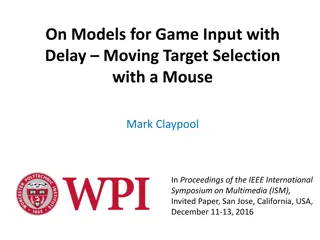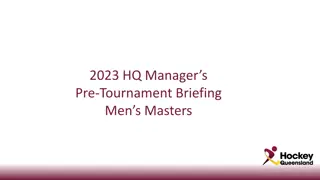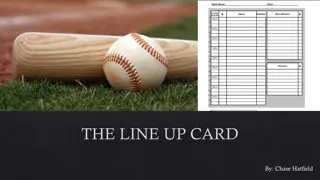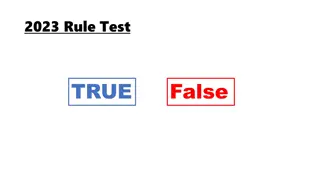ANEFO Meeting on Player Conduct: Rules and Regulations Summary
Eugene Borgonzi presented key rules and regulations regarding player conduct at the ANEFO Meeting on September 30, 2019. The sections covered include rules on assisting runners, illegal use of hands and holding, illegal blocking, and illegal personal contact. The detailed guidelines prohibit actions such as pushing, pulling, or lifting runners to aid in their forward progress, using impermissible blocking techniques, blocking in restricted areas or situations, and engaging in personal contact violations. The focus is on maintaining fair play and sportsmanship during gameplay to ensure the integrity of the sport.
Download Presentation

Please find below an Image/Link to download the presentation.
The content on the website is provided AS IS for your information and personal use only. It may not be sold, licensed, or shared on other websites without obtaining consent from the author.If you encounter any issues during the download, it is possible that the publisher has removed the file from their server.
You are allowed to download the files provided on this website for personal or commercial use, subject to the condition that they are used lawfully. All files are the property of their respective owners.
The content on the website is provided AS IS for your information and personal use only. It may not be sold, licensed, or shared on other websites without obtaining consent from the author.
E N D
Presentation Transcript
Conduct of players and others ANEFO Meeting 9/30/2019 By Eugene Borgonzi
Section 1 helping the runner An offensive player shall not PUSH, pull or lift the runner to assist his forward progress Only difference from NCAA is PUSHING. NCAA did away with pushing a few years ago.
Section 2 illegal use of hands and holding An offensive player (except the runner) shall not: Use a blocking technique which is not permissible by rule Two permissible techniques (same for the defense): Closed or Cupped Hand Technique Open Hand Technique Refer to definition of blocking in Rule 2-3-2 Grasp or encircle any teammate to form interlocked blocking Hold an opponent (same for the defense) The runner may not grasp a teammate A defensive player shall not: Use his hands to add momentum to the charge of a teammate who is on the line of scrimmage Contact an eligible receiver who is no longer a potential blocker
Section 3 illegal blocking Blocking below the Waist outside the free blocking zone Receiver who has given a valid or invalid fair-catch signal Blocking the kicker or place-kick holder of a free kick before: He has advanced 5 yards beyond his free-kick line; or The kick has touched the ground or any other player Chop block (High-Low) or clip (unlike NCAA clipping is not allowed in the tackle box) Block in the Back except: In the free blocking zone Using hands and arms when attempting to reach the runner or recover a loose ball which he may legally touch/possess
Section 3 illegal blocking (continued) No member of the kicking team shall initiate contact to an opponent on a free kick until: The legal kick has traveled 10 yards The kicking team is eligible to recover a free-kicked ball; or The receiving team initiates a block within the neutral zone
Section 4 illegal personal contact No fighting Shall not intentionally contact a game official No player or nonplayer shall: Kick, knee, strike or trip an opponent Charge into or throw an opponent to the ground after he is obviously out of the play or after the ball is clearly dead either in or out of bounds Pile on any player who is lying on the ground Hurdle an opponent who has one or both feet on the ground Position himself on the shoulders or body of a teammate or opponent to gain an advantage Throw a helmet to trip an opponent
Illegal contact (continued) No player or nonplayer shall: Make any other contact with an opponent which is deemed unnecessary or excessive and which incites roughness Grasp on opponent s face mask, edge of helmet opening, ear hole, chin strap, or mouthpiece and twist, turn or pull (if you call it s a 15 yard penalty) Horse collar an opponent even if possession is lost Initiate contact with an opposing player whose helmet has come completely off Target an opponent Execute a blindside block outside of the free blocking zone with forceful contact unless initiated with open hands
Illegal contact (continued) Initiate illegal helmet contact Butt block act by any player who initiates contact against an opponent who is not a runner with the front of his helmet Face tackling act by a defensive player who initiates contact against a runner with the front of his helmet Spearing act by any player who initiates contact against an opponent at the shoulders or below with the crown of his helmet Illegal helmet contact may be judged a flagrant act by official. Examples include: Contact against opponent on ground Contact against opponent being held up by other players and/or: Contact against a defenseless opponent
Illegal contact (continued) Roughing the passer Contacting a passer who has thrown the ball from in or behind the neutral zone after it is clear the ball has been thrown. Running into or roughing the kicker or holder Run = contact that displaces the kicker or holder without roughing Roughing = block, tackle or charge into the kicker or holder other than when: Contact is unavoidable because it s not reasonably certain that a kick will be made Defense touches the kick near the kicker and contact is unavoidable Contact is slight and is partially caused by movement of the kicker Contact is caused by R being blocked into the kicker/holder by K Roughing the Snapper Defense shall not charge directly into the snapper when the offensive team is in a scrimmage kick formation
Illegal contact (continued) No defensive player may use his hand to slap the blocker s head Unintentional contact between a nonplayer and a game official in the restricted area while the ball is live KEEP EVERYONE OUT OF THE WHITE!!!!!!!! First offense 15 yards from succeeding spot Second offense: 15 yards from succeeding spot and disqualification of the head coach All fouls under this section if deemed flagrant by an official will result in disqualification
Section 5 noncontact uns by players Baiting or taunting acts or words or insignia Profanity, insulting or vulgar language or gestures Delayed, excessive or prolonged act by which a player attempts to focus attention upon himself Using disconcerting acts or words prior to the snap in an attempt to interfere with offense s signals or movements (15 yard unsportmanlike instead of 5 yard delay of game under NCAA) Kicking at the ball other than during a legal kick or intentionally kick the ball Refusing to comply with an official s request Using alcohol or any form of tobacco products Spike the ball or throw the ball high into the air or from the field of play or end zone Intentionally fail to place the ball on the ground or immediately return it to a nearby game official
Section 6 illegal participation No player shall intentionally go out of bounds during the down and: (live-ball, basic spot) Return to the field Intentionally touch the ball Influence the play Otherwise participate If a player is blocked out of bounds by an opponent and returns to the field during the down, he shall return at the first opportunity. No replaced player, substitute, coach, athletic trainer or other attendant shall hinder an opponent, touch the ball, influence the play or otherwise participate. (live-ball, basic spot)
Illegal participation (continued) It is illegal participation: Any player, replaced player, substitute, coach, athletic trainer or other attendant enters and participates during a down (live-ball, basic spot) If an injured player is not replaced for at least one down; unless halftime or overtime intermission occurs (live-ball, previous spot) To have 12 or more players participating at the snap or free kick (live-ball, previous spot) To use a player, replaced player etc in a substitution or pretended substitution to deceive opponents at or immediately before the snap for free kick (live-ball, previous spot) For a player to be lying on the ground to deceive opponents at or immediately before the snap or free kick (live-ball, previous spot) For a disqualified player to re-enter the game (live-ball, previous spot) For a player whose helmet comes completely off during a down to continue to participate beyond the immediate action he was engaged in. (live-ball, basic spot)
Section 7 illegal kicking and batting No player shall intentionally kick the ball other than as a free or scrimmage kick No player shall bat a loose ball other than a pass or a fumble in flight, or a low scrimmage kick in flight which he is attempting to block in or behind the expanded neutral zone EXCEPTION: A K player may bat toward his own goal line a grounded scrimmage kick or a scrimmage kick in flight which is beyond the neutral zone, if no R player is in position to catch the ball. Any pass in flight may be batted in any direction, by an eligible receiver unless it is a backward pass batted forward by the passing team A ball in player possession shall not be batted forward by a player of the team in possession
Section 8 noncontact uns by nonplayers Use of profanity, insulting or vulgar language or gestures Attempting to influence or indicating objections to a decision by an official Disrespectfully addressing an official Using any illegal communication equipment Holding an unauthorized conference Failure to comply with restrictions of Rule 3-2-2 at the coin toss Failure to be ready to start the first half Failure to be on the field following the conclusion of halftime or be ready to start the second half at the conclusion of the mandatory warm up period
Noncontact uns by nonplayers (continued) Following pre-game verification, A coach allowing his players to use illegal equipment Being on the field except as a substitute or replaced player Using alcohol or any form of tobacco product Being outside the team box, but not on the field (between the 25 yard lines) A substitute leaving the team box during a fight A maximum of three coaches may be in the restricted area however no player, nonplayer or coach shall be in the restricted area when the ball is live.























